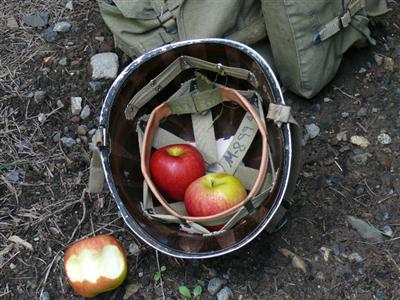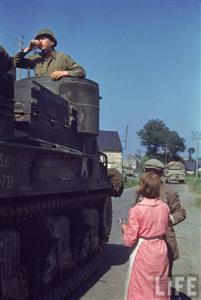Non Ration Foodstuffs: Normandy
Published: Winter, 2010
Author: Charles McFarlane
90th IDPG
Despite being under Nazi occupation since 1940, some Frenchmen managed to make the best of things during the war. The Germans conquered Europe and subesequently bankrolled the purchase, not outright seizure, of foodstocks and supplies for their war machine. Food was rationed and commodities controlled, but there remained a fairly open agricultural market system during the occupation.
Photo from the Normandie ArchiveThe big changes happened when the Americans and Anglos came. By and large, it was the policy of the US Army to bring what was needed and buy very little locally unlike the Germans. Troops were supposed to have adequate rations and not be required to spend allowances or out of pocket money for basic foodstuffs. When the opportunity presented itself, GI's certainly purchased local food, spirits and "commodities".
Under combat conditions, things were entirely different...
In the front lines, GI's didnt always recieve adequate rations - and in some cases werent even provisioned due to their expected imminent loss. This left many to forage for what could be had, with all pleasantries left miles and weeks behind.
GI's found farmhouse cellars and root cellars as a source for food. These farmhouses and cellars could be a booby trapped hell hole or a cornucopia of vegetables, preserved fruit and alcohol.
Fruit
Fruit seems to have been much harder to find in France than it was in Africa, Sicily, and Italy. Common types of fruit to Northern France were the peach, apple, and pear. Though apples in Normandy would have been rare in June and July, cider and the distilled cider spirit, Calvados was abundant.
“As we entered the outskirts of Metz, we walked through what was obviously an old orchard. What was different about this one was that in such ancient orchards the trees are quite tall. In this one the trees were not much over 10 feet high. There were small yellow colored apples on the trees. I tasted one. The texture told me it was fully ripe, but UGH! The flavor was sour, bitter, and with a hard texture. Such an apple had to be intended for some special German dish, possibly some pastry dish.”
Frank Wayne Martin, Private First Class, Forward Observer for General Patton
What should I look for when buying fruit for an event?
Apples
When you think of France and particularly Northern France you should immediatley think Apples. This isnt the American way of Apples for a casual snack, or apple pie - but rather Apple Cider, Hard Cider and Calvados, a very destinct Apple Liqour.
We're going to focus on several apple varities and their visual approximates for this article. The three varities are the Muscadet de Dieppe, the Orleans Reinette and the Pippin.
Muscadet de Dieppe
The Muscadet de Dieppe apple is a small apple with an orange to red skin, bittersweet in flavor. This was and is one of the primary cider used in the production of Calvados liquor.
Orleans Reinette
The Orleans Reinette is a yellow to green apple with hints of red on the sunward side of the apple. This is a medium sized apple suitable for eating as well as the production of cider.
Pippin
The Pippin apple has seen many incarnations and breeds over the centuries. The Pippin of Normandy produces a medium sized, yellow skinned apple with slightly yellowish coarse flesh.
Apples, of the Liquid VarietiesCider
We've all had cider at one point in our lives, just simply pressed apples for their non-alcoholic juice.
Raw cider was pressed from hundreds of varieties of apples, both edible and inedible, grown in Normandy.
Frequently, cider was fermented into low alcohol content hard cider which was consumed as is, or used as a base for Calvados.Calvados
Calvados is a single or double distilled hard liqour made from hard cider. Much like other brandies, it is best when aged - but can be drunk shortly after distillation.
Throughout veterans testimonies and stories - Calvados and hard cider is a reoccurring theme when discussing Northern France.
Photo from the Life Archive powered by Google
Pears
Pears are also widely cultivated in France and specifically Normandy. There are numerous varities to chose from available in the US to approximate the pears of France.
For more reading on Pear varities, check out
Barklips Micro Nursery - Pear Tree Descriptions
Conclusions
If you're going to take fresh fruit to a northern France / Normandy event to eat - apples or pears are your best bet. For adult beverages, Wine is not always the most correct choice for anything in "France". Cider, hard cider and apple brandy or legitimate Calvados would be the more accurate beverage.
90th
IDPG Research







